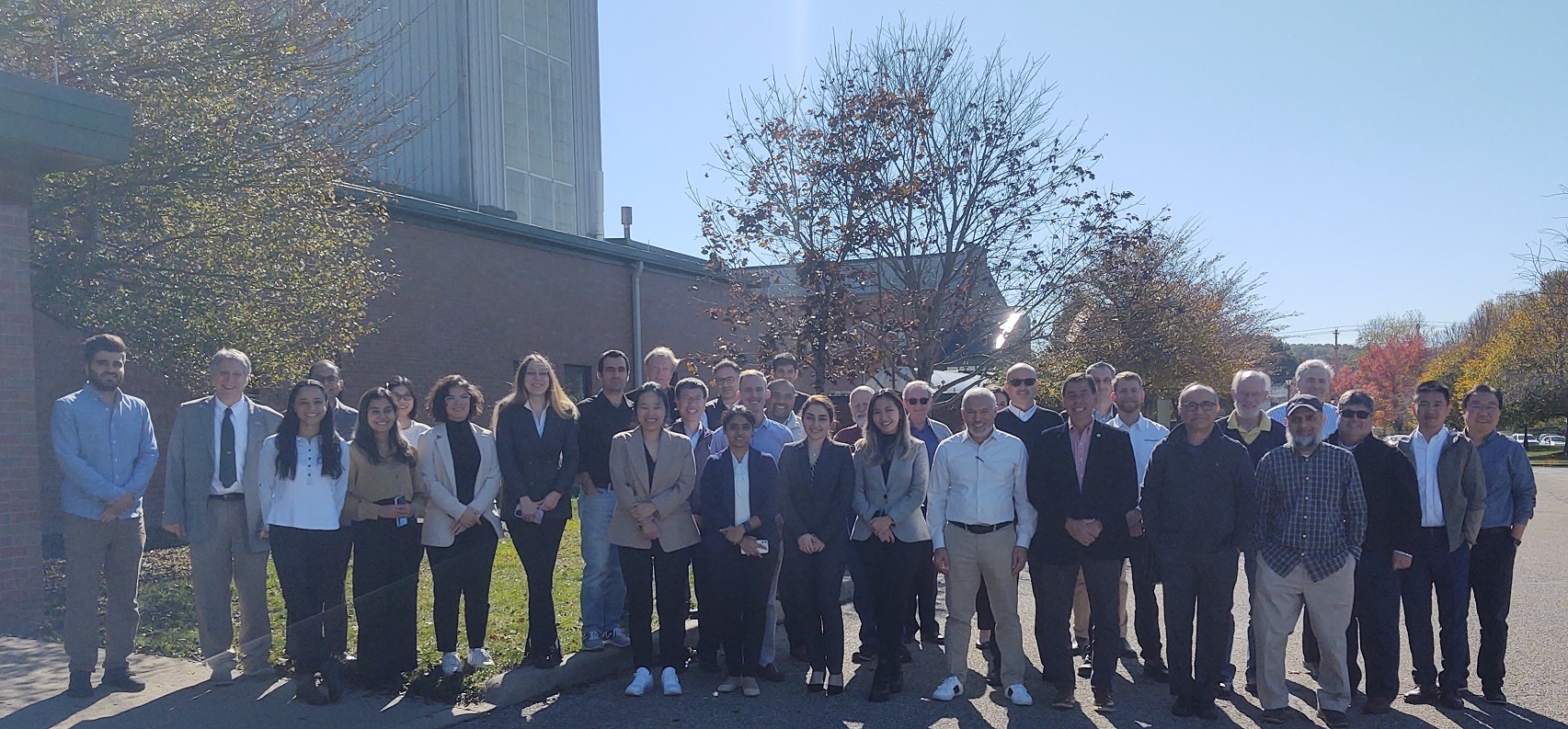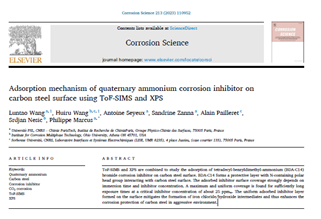|
Shrirang Deshmukh Makes it 2-in-a-Row
|
Mid-November marks Ohio University's International Education Week, and its Student Global Research Symposium.
In 2022, ICMT PhD student Yi He took first place in its associated 3-Minute Thesis competition.
This year, ICMT's Shrirang Deshmukh (SD) repeated the win taking the $500 prize, presenting on "The Effect of Oxygen on Corrosion in the Oil and Gas Industry".
He narrowly beat out fellow finalist and ICMT PhD student Zhuldyz Zhigulina, who presented on "Insight into High Temperature CO2/H2S Corrosion of Mild Steel".
This is a terrific achievement for both, and recognition of ICMT research in the broader OHIO community.
|
|
|
CC JIP 2023 Fall Meeting October 24-26
|
The 2023 Fall meeting of the CC JIP was held on October 24-26 at ICMT in Athens, OH.
In attendance were 14 representatives from 9 of our current sponsoring companies while more representatives from our other sponsoring companies joined us in real time online.
Over the 2 ½ day event, our students and staff provided 16 presentations for review and discussion.
An update to MULTICORP V6.0 was released prior to this meeting and was reviewed on Thursday after the member's meeting.
As usual, many great in-depth discussions occurred during the meeting with positive feedback for the current research directions. The photo below shows attendees from this event:
|

|
|
|
President, Provost & Dean
|
Ohio University President Lori Stewart Gonzalez, Provost Elizabeth Sayrs, and Russ College of Engineering & Technology Dean Patrick Fox made a combined visit to our laboratory.
They learned about the three-decade history behind ICMT, our ongoing activities, and future plans. They then toured the laboratory floor,
were shown key items of equipment employed in corrosion testing. Our PhD students Shrirang Deshmukh, Adam Cutright, Ishan Patel, Neda Norooziasl, Kamila Turganova,
Zhuldyz Zhigulina, Yi He, and Martin Colahan showcased their research in a poster format, demonstrating the diversity of our research activities.
University photographer Eli Burris cataloged the visit, and we thank him for the pictures below.
|
|
|
Payman Sharifi Abdar Doctoral Defense
|
PhD student Payman Sharifi Abdar has successfully defended his dissertation research, "Mechanism and Modeling of Galvanic Corrosion between Mild Steel and Iron Sulfides in Acidic Solutions".
Research within ICMT previously demonstrated that formation of different types of iron sulfides as corrosion products were a main culprit in localized attack,
due to their wide-ranging physicochemical properties. Galvanic coupling between such iron sulfide layers and mild steel was suspected to be associated with the observed localized attack.
The two types of iron sulfides investigated by Payman, pyrite and pyrrhotite, were shown to produce different galvanic corrosion due to their distinct electrochemical behaviors.
To further elucidate the mechanism of the impact of iron sulfide type, the cathodic behavior of pyrite and pyrrhotite was systematically studied using a rotating disk electrode system.
The results revealed that pyrrhotite has significantly higher cathodic current than pyrite. This difference originates from different cathodic reactions occurring at the surface of these iron sulfides.
Manuscripts are in preparation relating to his findings. He has previously published in Electrochimica Acta and Analytical Methods. He has been a regular attendee at NACE and AMPP conferences,
receiving 2nd place in the Mars Fontana Category for his research poster at CORROSION 2021.
Payman's PhD advisor was University Distinguished Professor, and ICMT Director, Srdjan Nesic.
He recently started a post-doctoral researcher position in the University of Pittsburgh's Department of Chemical & Petroleum Engineering, with an electrocatalysis research focus.
|

Post-defense, Payman with his committee members and project leaders.
|
|
|
Mohiedin Bagheri PhD Defense
|
ICMT PhD student Mohiedin Bagheri has successfully defended his dissertation research, "Mechanism of Anodic Dissolution of Iron and Steel in CO2 Environments".
His research focus was the mechanistic investigation of the multistep reaction that occurs during CO2 corrosion.
After critical review of the fundamental theories underpinning the oxidative dissolution reaction, he developed a simpler narrative that was successfully applied in corrosion modelling.
Furthermore, has research yielded important insights into how specific environmental factors (e.g., pH, dissolved CO2, temperature, steel type, etc.)
can mechanistically impact kinetics of elementary steps, and ultimately the overall reaction of iron dissolution. His advisor was Professor Srdjan Nesic,
his committee members were Professor Howard Dewald, Associate Professor Katherine Cimatu, Associate Professor Marc Singer and Research Associate Professor Yoon-Seok Choi.
Mohiedin holds a MS degree in Chemical Engineering, also from OHIO, as well as BSc and MSc degrees in Materials Science & Engineering from Sharif University of Technology.
He has published in the peer reviewed journals Advanced Materials, Materials & Design, Journal of the Electrochemical Society, Materials Science & Engineering,
Australian Journal of Chemistry, Electrochimica Acta, and Analytical Methods. He will be joining OLI as an Electrolyte/Corrosion Simulation Specialist.
|

|
|
|
Russ Outstanding Research Paper Award for 2022:
“Machine learning modelling of time-dependent corrosion rates of carbon steel in the presence of corrosion inhibitors”
M. Aghaaminiha, R. Mehrani, M. Colahan, B. Brown, M. Singer, S. Nesic, S. Vargas, and S. Sharma, Corrosion Science, 193 (2021)
|
The Russ Outstanding Research Paper Award recognizes excellence in research and scholarship exhibited by the faculty of Russ College and is awarded by recognition from a committee consisting of previous award recipients.
(For more information click here.)
The team chosen for the award at the Institute for Corrosion and Multiphase Technology focused their efforts on modeling experimental data obtained from a series of experiments
on corrosion inhibition of mild steel in CO2 saturated aqueous solutions. Regression analysis was performed using different ML algorithms (Artificial Neural Network,
Random Forest, Support Vector Machines, and K Nearest Neighbors) to model experimental data of time-varying corrosion rates of mild steel specimens when corrosion inhibitors
were added to the system in different concentrations and dose schedules and with and without pre-corrosion. One of the main conclusions was that the sensitivity of corrosion
rates to changes in the environmental variables could be well-predicted by the trained RF model, which can eliminate the need to perform extensive experiments for different
solution conditions in the lab. The paper can be found
here.
|
|
|
ICMT Grad Student Recognition at OU’s EXPO 2023
|
Every Spring semester, Ohio University stages its Student Research and Creative Activity Expo. As usual, ICMT had multiple graduate students showcasing their research on the floor
of our campus’s Convocation Center.
Presenting his poster on Inhibitor Adsorption Characterized using Quartz Crystal Microbalance, Kushal Singla took 1st place in the Special Session
Awards conferred by the University International Council. Yi He also took 1st place for Effect of Intermittent Wetting on Corrosion Inhibition in Oil/Water Systems with the Best Content
Award by the Graduate Student Senate.
Adam Cutright took 2nd place in ChemBioEng2 with Impact on Corrosion and Corrosion Product Layers by Trace Concentrations of H2S, Martin Colahan took 2nd place in ChemBioEng1 on
Development of a Downhole Corrosion Modeling Software, and Shrirang Deshmukh also took 2nd with Anomalies Associated with the Oxygen Reduction Reaction.
The Expo is an excellent event where undergraduate and graduate students can also network, see each other’s research, and exchange ideas. A highlight in OHIO’s calendar!
|
|
|
Huiru Wang Recognized as OHIO's 2023 Outstanding Chemical Engineering PhD Student
|
Hearty congratulations to Huiru Wang upon her selection for the Gustavus Edward and Gladys V.
Smith Memorial Engineering Award, recognizing her as the Department of Chemical & Biomolecular Engineering's outstanding PhD student.
Along with a monetary component, she will be presented with a plaque for the award at the Russ College 2022-2023 Student Awards Ceremony
and luncheon on April 22 from 11:00am to 3:00pm at the Ridges Auditorium, hosted by the Russ College chapter of Tau Beta Pi, the engineering honor society.
|
|
|
ICMT at the 2023 AMPP Annual Conference
|
As is our norm, ICMT sent a healthy contingent to the AMPP Annual Conference in Denver.
In total, 18 presentations were made and 17 posters displayed. Symposia participated in covered Corrosion Control with Inhibition,
Progress in Laboratory Testing of Corrosion Inhibitors, Sweet and Sour Corrosion, VCI Applications, Corrosion in Supercritical Systems,
Machine Learning, Mechanisms of Localized Corrosion, Refining Industry Corrosion, RIP, and Electrochemical Techniques.
ICMT PhD students were also recognized by AMPP. Sahithi Ayyagari and Kushal Singla each received the Graduate Student Book Award,
with Sahithi also receiving the Oliver Moghissi Memorial Scholarship. Kushal along with Neda Norooziasl were also selected for the AMPP Member Leadership Development Program.
Recent ICMT research scholar Bernardo Santos, who we count as one of our own, was awarded the AMPP Diversity and Inclusion Grant.
Internal planning is already underway for our participation in the 2024 AMPP Annual Conference in New Orleans.
|
|
|
ICMT Duo Huiru Wang and Luntao Wang Publish Groundbreaking ToF-SIMS, XPS Manuscript
|
During their research at Université PSL and Sorbonne Université, recent ICMT PhD Huiru Wang and current post-doc Luntao Wang collaborated on a surface analysis investigation
that is now published in Corrosion Science, "Adsorption mechanism of quaternary ammonium corrosion inhibitor on carbon steel surface using ToF-SIMS and XPS".
In their groundbreaking work, they combined Time-of-flight secondary ion mass spectrometry (ToF-SIMS) and X-ray photoelectron spectroscopy (XPS) to characterize adsorption
phenomena associated with the corrosion inhibitor molecule
tetradecylbenzyldimethylammonium on a mild steel surface. They demonstrated that the adsorbed inhibitor surface coverage strongly depends on immersion time and inhibitor
concentration, with a maximum as well as uniform coverage is found for sufficiently long exposure times at a critical inhibitor concentration of ca. 25 ppmw.
The uniform adsorbed inhibitor layer formed on the surface was determined to mitigate the formation of iron chloride/hydroxide intermediates, thus enhancing the corrosion
protection of carbon steel in aggressive environments. The manuscript can be accessed here: (ScienceDirect.com).
|

|
|
|
|
|
|
|
|
|
|
|
|
|
|
|
|
|
|
|
|
|
|
|




